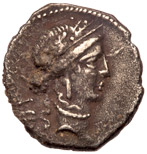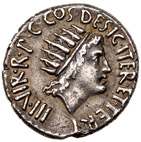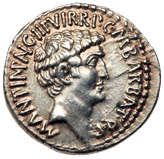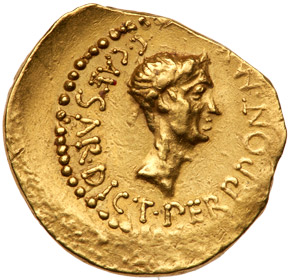
|
Sale 135
The Pre-Long Beach Sale June
| Roman Imperatorial Period Coinage |
| |
| |
| Lot |
Photo |
Description |
Realized |
Lot 1732 |
 |
Julius Caesar. Silver Denarius (3.67 g), 48 BC. Military mint traveling with Caesar. Diademed and wreathed head of Pietas or Clementia(?) right; behind, LII. Reverse: CAE-SAR, trophy of Gallic arms; to right, axe surmounted by an animal's head. Crawford 452/2; HCRI 11; Sydenham 1009; RSC 18. Toned. Very Fine. Estimated Value $350 - UP
Dr. E. Elovic Collection.; Ex Archaeological Center, R. Deutsch 67 (17 October 2019), 229.
View details and enlarged photos
Realized
$576 |
|
Lot 1733 |
 |
Mark Antony. Silver Denarius (3.78 g), 38 BC. Athens. M ANTONINVS M F M N AVGVR I(MP) TER, Mark Antony, veiled and wearing the priestly robes of an augur, standing right, holding lituus. Reverse: IIIVIR R P C COS DESIG ITER ET TERT, Radiate head of Sol right. Crawford 533/2; HCRI 267; Sydenham 1199; RSC 13a. Well centered and with full legends. Choice Very Fine. Estimated Value $500 - UP
The Dr. E. Elovic Collection; Ex Archaeological Center, R. Deutsch 60 (26 April 2016), 55.
View details and enlarged photos
Realized
$528 |
|
Lot 1734 |
 |
Mark Antony. Silver Denarius (3.61 g), 32-31 BC. Legionary type. Patrae(?). ANT AVG III VIR R P C, praetorian galley right. Reverse: LEG II, legionary eagle right between two standards. Crawford 544/14; HCRI 349; Sydenham 1216; RSC 27. Boldly struck and well centered. A choice example. Lighty toned. Extremely Fine. Estimated Value $300 - UP
Dr. E. Elovic Collection; Ex Guy Marag Collection (Archaeological Center, R. Deutsch 64, 4 April 2018), 102.
View details and enlarged photos
Realized
$870 |
|
Lot 1735 |
 |
Mark Antony & Octavian. Silver Denarius (3.89 g), 41 BC. Ephesus. M. Barbatius Pollio, quaestor pro praetore. M ANT I(MP) (AV)G III VIR R P C M BARBAT Q P, bare head of Mark Antony right. Reverse: CAESAR IMP PONT III VIR R P C, bare head of Octavian right. Crawford 517/2; HCRI 243; Sydenham 1181; RSC 8a. Lustrous surfaces. Superb Extremely Fine. Estimated Value $2,500 - UP
Mark Antony is reported to have lived extravagantly while in the East, and he exacted large sums from the cities of Asia Minor to finance this lifestyle. It is certainly from these funds that he obtained the bullion to produce this extensive and handsome coinage, struck with the name of his lieutenant M. Barbatius Pollio. Pollio's colleagues, M. Cocceius Nerva (a distant ancestor of the future emperor Nerva) and L. Gellius Poplicola, also struck similar types honoring both Antony's fellow triumvir, Octavian and his brother, Lucius Antony, but the majority are of a different style and are believed to have been struck after Antony's departure from Ephesus.
View details and enlarged photos
Realized
$2,880 |
|
Lot 1736 |
 |
Octavian, with Julius Caesar. Gold Aureus (8.11 g), 43 BC. Military mint in Gaul. C CAESAR COS PO(NT) (AV)G, bare head of Octavian right. Reverse: C CAESAR DICT PERP PO(NT) (MA)X, laureate head of Julius Caesar right. Crawford 490/2 (R3); CRI; Sydenham 1321; Newman "A Dialogue of Power in the Coinage of Antony and Octavian," ANS AJN 2 (1990), 43.9; Calicó 52. Extremely Rare, with a contemporary portrait of Julius Caesar in gold. Although struck off-center, both portraits are superb and complete. Choice Very Fine. Estimated Value $100,000 - UP
Not only is this aureus desirable for its intrinsic value as a piece of ancient gold, for its rarity in the Roman Republican series, and for its depiction of Octavian and Julius Caesar�the defining figures of the late Republic and the Empire�but it is extremely important for the moment in time that it captures.
On March 15, 44 BC, Julius Caesar was struck down in the Curia by Brutus, Cassius, and other, less famous assassins, who hoped that his death would end dreams of monarchy in Rome and restore some semblance of the old Republic. As a means of preventing an immediate collapse of the Roman state machinery, Caesar's lieutenant Mark Antony brokered a deal in the Senate which provided that all of the Dictator's appointments would remain in force, but that none of his killers would be prosecuted. Unfortunately, Julius Caesar had been extremely popular with the lower classes of Rome and this modus vivendi held little appeal for them. Realizing their potential power, Antony harnessed their rage and threatened to use it against both Caesar's assassins and any senators who opposed him, perhaps with an eye to following in the Dictator's footsteps and becoming the new master of Rome.
At the same time that Antony was trying to maintain order at Rome, Gaius Octavian, the 18-year-old grand-nephew of Caesar who was also his adopted son and sole heir was sailing from Apollonia to Brundisium in order to claim his inheritance. At first Antony did not consider Octavian a serious threat to his authority, but he learned otherwise over the course of 43 BC. When Decimus Brutus, one of Caesar's assassins, refused to give up his province of Cisalpine Gaul when it was demanded, Antony marched north to besieged him at Mutina. However, Octavian, using his immense popularity as Caesar's heir, raised an army and joined the consuls Aulus Hirtius and Gaius Pansa in attempting to lift the siege. Despite managing to kill both consuls in two battles, Antony was finally forced to withdraw to avoid entrapment by a circumvallation wall that Octavian ordered to be constructed around his besieging force. Decimus Brutus subsequently thanked Octavian for saving him, but the latter coldly responded that he had only come to oppose Antony and not to aid the killers of his adoptive father.
In the aftermath of Antony's defeat at Mutina, the Senate declared him a public enemy, not realizing that Octavian was now marching on Rome to compel his recognition as a new consul and to force its recognition of his status as Caesar's heir and its open condemnation of his assassins. Octavian arrived in Rome on August 19, 43 BC, to make his demands known. The Senate acquiesced, but cynically lifted its earlier declaration against Antony in the hope that he might still oppose Octavian. This hope was dashed by autumn of 43 BC as elements in the army and Marcus Lepidus, Caesar's former magister equitum, worked to make peace between Octavian and Antony. The fruits of their labor shone forth in the passage of the lex Titia on November 27, 43 BC. This legislation established Octavian, Antony and Lepidus as the triumviri rei publicae constituendae ("thee-man commission for restoring the constitution of the republic"), or simply, the Second Triumvirate. It gave them sweeping legal authority that overrode all other Roman magistrates in Rome and the provinces. Despite being tasked with the restoration of the republican constitution, the Roman Republic really was dead and the Second Triumvirate merely set in motion the process that ultimately lead to the Roman Empire of Augustus in 27 BC.
This aureus was struck by a military mint moving with Octavian in Cisalpine Gaul in July-August 43 BC, when it was not yet clear what would happen next. It was struck when the War of Mutina had ended in defeat for Antony, perhaps as a donative to increase the loyalty of the army on the eve of Octavian's march on Rome and against the Senate, when Antony was an outlaw but still a potential threat and before there could have been any thought of a Second Triumvirate to end the conflicts within the Caesarean faction. As such, this aureus encapsulates a period of the greatest uncertainty for Octavian, Antony and for Rome.
The coin types attempt to mitigate some of the danger and precariousness of the situation for Octavian by cashing in on the popularity of Julius Caesar with the legions under his command. A remarkably veristic head of Julius Caesar appears on the reverse along with the titles he held at the time of his murder�his posthumous deification was still to come in 42 BC�paired with the portrait of the young Octavian on the obverse. To fully capitalize on his relationship, the legend surrounding this portrait names Octavian only by his nomen and adoptive cognomen, C. Caesar, thereby making it clear that he was the new Caesar in town and ready to carry on the work of the Dictator.
Ex NYS XLII (9 January 2018), 427; Gasvoda Collection (NAC 94, 6 October 2016), 15; NGSA 4 (11 December 2006), 142; Vinchon (23 April 1976), 209.
View details and enlarged photos
Realized
$90,000 |
|
|
|